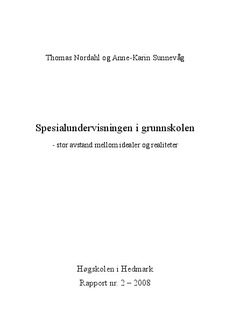| dc.contributor.author | Nordahl, Thomas | |
| dc.contributor.author | Sunnevåg, Anne-Karin | |
| dc.date.accessioned | 2008-05-07T13:06:39Z | |
| dc.date.issued | 2008 | |
| dc.identifier.isbn | 978-82-7671-655-9 | |
| dc.identifier.uri | http://hdl.handle.net/11250/133784 | |
| dc.description.abstract | Norsk: I denne rapporten presenteres noen sentrale empiriske resultater relatert til spesialundervisning og elever med ulike problemer og vansker i skolen. Dataene er hentet fra en kartleggingsundersøkelse ved årsskiftet 2006/07 ved 104 grunnskoler i Norge. Informanter er elevene fra 5.–10. klasse og deres kontaktlærere. Intensjonen er ikke å gi en vurdering av spesialundervisningens resultater eller effekter fordi dette empiriske materialet ikke gir grunnlag for det. Hensikten med rapporten er å presentere et bilde av hvordan elever som mottar spesialundervisning opplever hverdagen i dagens grunnskole.
Resultatene viser at ca. 20 % av elevene i grunnskolene defineres av lærerne til å ha vansker eller diagnoser. I vårt materiale mottar 7,4 % av disse elevene spesialundervisning. Dataene viser en markant økning av spesialpedagogisk hjelp fra barnetrinnet til ungdomstrinnet. Andelen elever som mottar spesialundervisning er størst på 9. klassetrinn. Disse funnene er ikke i samsvar med ambisjonen om tidlig innsats i forhold til barn og unge som har problemer i skolen. Spesialundervisningen settes inn alt for sent.
Elever som mottar spesialundervisning skårer signifikant dårligere enn andre
elever på nesten alle områder som blir målt. De elevgruppene som kommer dårligst ut på alle resultatområdene er elever med atferdsproblemer med og uten ADHD-diagnose. De trives dårligere på skolen enn alle andre grupper av elever, de viser en dårlig atferd, de opplever å ha et dårligere forhold til medelever, de har lavere motivasjon og arbeidsinnsats og dermed et langt dårligere læringsutbytte.
Innenfor elevgrupper med samme vansker er det liten forskjell i resultater enten
de mottar eller ikke mottar spesialundervisning. Det kan se ut til at det er flere forhold enn elevens behov som avgjør hvem som får spesialundervisning.
Fraværet av forebyggende innsats i skolen sammen med et sterkt kategorisk og individorientert perspektiv kan forklare den sene innsatsen som spesialundervisningen
bærer preg av. Det resulterer i at elever fratas rettigheter de har, det innebærer en sløsing med økonomiske ressurser og det er en uheldig anvendelse av faglig kunnskap. | en |
| dc.description.abstract | English: In this report, central empirical findings are presented in relation
to special education and students with different problems and difficulties in
school. The information is gathered from a survey investigation undertaken in
104 compulsory primary and lower secondary schools in Norway in 2006/07.
Informants are students in the 5th to 10th grades and their teachers. The intention is
not to evaluate the results or effects of special education as our empirical findings
are no basis for such an evaluation. The purpose of the report is to present a
picture of how students receiving special education experience school.
The survey shows that almost 20 % of the students are described by their teachers
as having difficulties or even a diagnosis. In our study, 7,4 % of these students
receive special education. The data show a clear increase in special educational
needs from compulsory primary to lower secondary school. The 9th grade has the
largest group of students receiving special education. These results do not meet
the ambitions of early efforts to help children with problems in school. Special
education is offered too late.
Students that receive special education get significantly poorer results compared
to other students in nearly all of the tested areas. The groups of students that get
the poorest results in all tested areas are those with behavioural problems, both
with or without an ADHD-diagnosis. They enjoy school less than other students,
they display poor behaviour, they experience poorer social relationships with
other students, their motivation and work efforts are low and they thereby learn
much less than other students. There is little difference in the test results among groups of students with similar
difficulties, regardless of wether or not they are receiving special education.
It appears that other factors than the students’ needs that determine who will
receive special education.
The absence of preventive efforts in school along with a strong categorical
and individually oriented perspective may explain the late effort that special
education suffers from. This results in the deprivation of the students` rights
and wastes important economical resources. It is also an unfortunate misuse of
professional knowledge. | |
| dc.format.extent | 567032 bytes | |
| dc.format.mimetype | application/pdf | |
| dc.language.iso | nor | en |
| dc.relation.ispartofseries | Rapport | en |
| dc.relation.ispartofseries | 02/2008 | en |
| dc.subject | spesialundervisning | en |
| dc.subject | tilpasset opplæring | en |
| dc.subject | vanskegrupper | en |
| dc.subject | grunnskole | en |
| dc.title | Spesialundervisningen i grunnskolen : stor avstand mellom idealer og realiteter | en |
| dc.title.alternative | Special education in compulsory primary and lower secondary school : a large difference between ideals and realities | |
| dc.type | Research report | en |
| dc.subject.nsi | VDP::Social science: 200::Education: 280::Special education: 282 | en |
